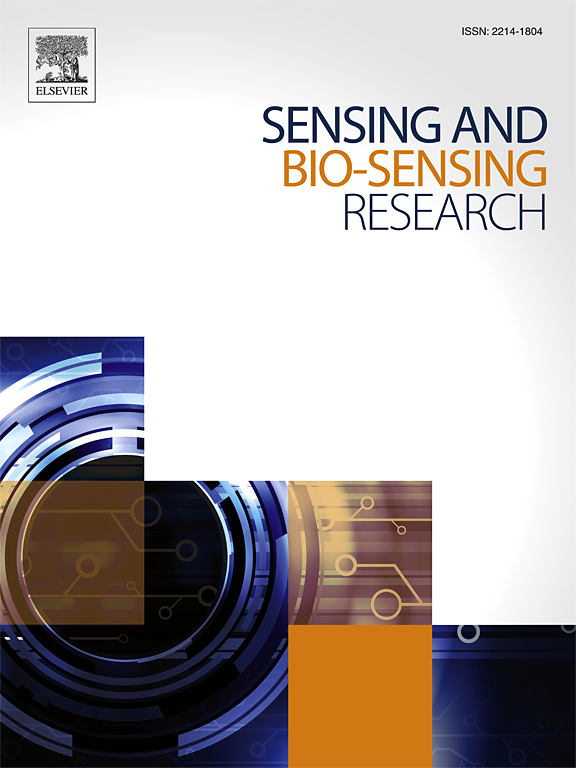尿液样本中肌酐的智能传感:利用cu纳米线/MoS2量子点和机器学习
IF 5.4
Q1 CHEMISTRY, ANALYTICAL
引用次数: 0
摘要
在临床实践中,血清肌酐(CRT)水平是诊断、分期和监测肾脏疾病的关键生物标志物。本文采用铜纳米线(CuNW)和二硫化钼量子点(MSQD)修饰的玻碳电极(GCE)对复杂混合物和尿液样品中的CRT进行了电化学检测。采用FESEM、XRD、UV、PL和FT-Raman等物理表征方法对材料进行了表征。采用循环伏安法(CV)和差分脉冲伏安法(DPVs)研究了传感器的电催化活性。尽管电化学传感器具有较高的灵敏度和成本效益,但传感器的性能受到产生冲突和重叠电化学特征的干扰物质的存在的限制。为了解决这个问题,我们实施了一种机器学习(ML)方法来准确量化复杂混合物以及尿液样本中的CRT水平。所采用的机器学习算法在大型数据集上进行了训练和测试,使它们能够有效地捕获和分析电化学特征中的差异,从而展示了人工智能的应用。该传感器的线性范围为1.96 ~ 966.0 μM,在复杂混合物中检测限(LOD)为2.3 μM,在真实尿液样品中检测限(LOD)为0.001 μM,在人工神经网络和随机森林ML模型中RMSE分别为0.2和0.017 μM。我们预计,通过进一步小型化这些传感器到点护理测试设备,肾脏疾病可以有效地管理。本文章由计算机程序翻译,如有差异,请以英文原文为准。
Smart sensing of creatinine in urine samples: Leveraging Cu-nanowires/MoS2 quantum dots and machine learning
Serum creatinine (CRT) levels are key biomarkers for diagnosing, staging, and monitoring renal disease in clinical practice. In this work, copper nanowires (CuNW), and Molybdenum disulfide quantum dots (MSQD) modified glassy carbon electrode (GCE) were chosen to demonstrate the electrochemical detection of CRT in complex mixture and urine samples. The materials were characterized using various physical characterizations such as FESEM, XRD, UV, PL, and FT-Raman. The electrocatalytic activity of the sensor was investigated using cyclic voltammetry (CV), and differential pulse voltammetry (DPVs). Despite the elevated sensitivity and cost-effectiveness of electrochemical sensors, the performance of the sensors is constrained by the existence of interfering species that generate conflicting and overlapping electrochemical signatures. In order to address this issue, we implemented a machine learning (ML) approach to accurately quantify CRT levels in complex mixtures, as well as in urine samples. The ML algorithms employed are trained and tested on a large dataset, allowing them to effectively capture and analyze the variance in the electrochemical signatures, demonstrating the application of artificial intelligence. The proposed sensor exhibits linearity from 1.96 μM to 966.0 μM and shows the best performance in terms of limit-of-detection (LOD) of 2.3 μM in a complex mixture and 0.001 μM in real urine samples, with RMSE of 0.2 and 0.017 μM using artificial neural network and random forest ML models respectively. We anticipate that by further miniaturization of these sensors into point-of-care testing devices, renal diseases can be managed effectively.
求助全文
通过发布文献求助,成功后即可免费获取论文全文。
去求助
来源期刊

Sensing and Bio-Sensing Research
Engineering-Electrical and Electronic Engineering
CiteScore
10.70
自引率
3.80%
发文量
68
审稿时长
87 days
期刊介绍:
Sensing and Bio-Sensing Research is an open access journal dedicated to the research, design, development, and application of bio-sensing and sensing technologies. The editors will accept research papers, reviews, field trials, and validation studies that are of significant relevance. These submissions should describe new concepts, enhance understanding of the field, or offer insights into the practical application, manufacturing, and commercialization of bio-sensing and sensing technologies.
The journal covers a wide range of topics, including sensing principles and mechanisms, new materials development for transducers and recognition components, fabrication technology, and various types of sensors such as optical, electrochemical, mass-sensitive, gas, biosensors, and more. It also includes environmental, process control, and biomedical applications, signal processing, chemometrics, optoelectronic, mechanical, thermal, and magnetic sensors, as well as interface electronics. Additionally, it covers sensor systems and applications, µTAS (Micro Total Analysis Systems), development of solid-state devices for transducing physical signals, and analytical devices incorporating biological materials.
 求助内容:
求助内容: 应助结果提醒方式:
应助结果提醒方式:


